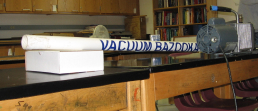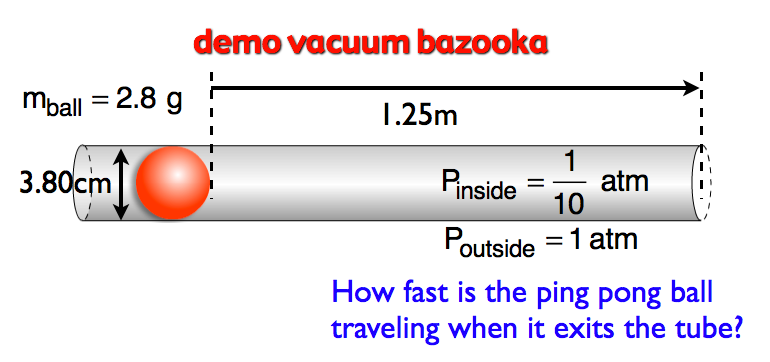Vacuum Bazooka [ Version 2.0 ]
Presenter: Tony Wayne, Albemarle High School, twayne[at symbol]albemarle.org.
Va. SOL:
PH.7 The student will investigate and understand properties of fluids. Key concepts include
density and pressure.
National Standards:
Fluids and pressure
Topic/Concept
Shows that pressure exerts a force and balance of pressure
Materials

|
• Vacuum Bazooka
• PingPong(tm) ball
• Vacuum pump |
• 3” wide sealing tape (Staples)
• Screw driver |
Safety Considerations |
 |
- The bazooka shoots a ping pong ball in excess of 600 mph!!! Don’t have anyone stand in front of it. Have a everyone stand far away. It will bounce off the wall it hits. It you drop or damage the pipe in ANY way. Get a new pipe. Irregularities, nicks and cracks can cause the pipe to implode and send pieces flying. Inspect the pipe before creating the vacuum.
- The initiation of the vacuum release is loud. Everyone should protect his or her ears.
- When dealing with vast differences in pressure, there is always a risk of implosion. BE SAFE. Always think of the students’ safety first. Keep the students far away from the pipe. Use it at your own risk. ( I assume no responsibility for your use of this design since I cannot oversee it’s safe use or construction. )
|
Presentation
Get a student volunteer to place the pingpong ball in the front of the bazooka. It will roll down the pipe until it hits the air stem inside. Place a piece of 3” sealing tape across the front and another piece against the rear. It needs to make a tight seal. Aim it towards a sturdy wall. Not towards a door, window or student. Pull the sides of the tape down on the pipe to hold it in place. Connect the vacuum pump. Keep your fingers away from the front and rear of the pipe now. You don’t want it to accidentally fire and do damage to your fingers or students. To “fire” the bazooka, stab the tape at the rear end with a screwdriver. It will ricochet off the wall it hits and make a VERY loud noise Then give the student worksheet to the students. It is a problem based on this demonstration.
How the physics is demonstrated
When the student removes her hand. The pressure is unbalanced. The 1 atmosphere of pressure at the rear of the bazooka pushes the ball forward.
Construction and Tips Regarding the Demonstraton
The bazooka is made from a piece of strong PVC pipe the same diameter at ping pong ball. The pipe can be found at a hardware store. It costs about $3 (2004 price). You MUST buy a schedule (SCH) 40 piece of PVC pipe. The “schedule” describes the pipes thickness. The walls of the pipe must be at about 1/8 of an inch thick or greater. If you get a thinner walled pipe, it WILL IMPLODE under the vacuum. Take a pingpong ball with you and look for a thick walled pipe that the ball snugly fits in. Mine is a 5 foot long pipe.
You will need to make a stem for the hose. You will need a 1 3/4“ piece of CPVC pips about _” in diameter, a CPVC 90° elbow to fit the CPVC and a brass fitting for the hose to slide over. Glue the pieces together with CPVC cement. WARNING: This stuff can kill you. Use it outside. Using it in a sealed room can stop your heart. Read and heed the warnings! Drill a hole about 6 inches from the rear of the 5’ PVC pipe. The hole should accommodate the CPVC pipe –but not the elbow connector. If you drill a hole that is too big, get a new piece of PVC pipe and start over again. Do not make the connection piece fit, if the hole is too big. It can be dangerous when you draw a vacuum in the pipe Glue the pipe in the hole. Any air leaks can be sealed with hot glue.
Finished.
|
 |
Here is a calculation you can do. I give this out as a student handout.








To find the speed, use kinematics. But you will need “a.”
To find “a” use F=ma
To find “F” use P=F/A. “A” is the cross-sectional area is the ball.
NOTE: You could use energy instead of kinematics to solve.









|